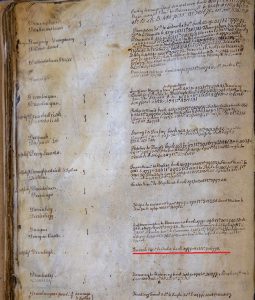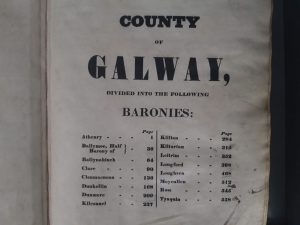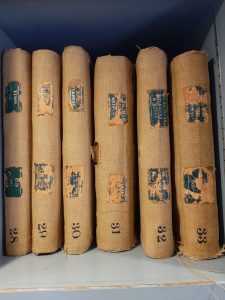A guide to using the Lands Index at the Registry of Deeds
For Explore your Archive 2020, we are delighted to launch a short introductory video and blog to using the Lands Index at the Registry of Deeds.
Introduction
To search for property transitions registered at the Registry of Deeds by geographical area, you can use our Lands Index. This is particularly useful if you do not know the name of the ‘grantor’ of the registered deed and are unable to use the Names Index books.
The Lands Index comprises 1429 volumes and were created by Registry of Deeds clerks who extracted information from the Memorials lodged at Registry of Deeds. To help users navigate which volume(s) to consult there is a Lands Index list available to view on our website. This lists the county, time period and corresponding volume number.
The Lands Index include the registered transaction for all 32 counties of Ireland up until 1921 when the Registry of Deeds Northern Ireland was established. From 1922 to 1946 contains the entries for 26 counties. For Dublin city and county only the index continues until 1949.
Lands Indexes 1708-1832
For the time period, 1708-1832, you must search by county and then by townland. Some of the larger corporation towns are listed separately at the back of the county book, whilst city entries including Dublin, Cork and Waterford are listed separately in their own volumes. For these earlier books, only the surname of the grantor and grantee is given with the Registry reference number.
For all of the Lands Indexes, the townland entries are alphabetical to the first letter only. Therefore, you must read every entry for a particular letter, which will run across multiple pages, to ensure you find all of the entries for a particular townland.

In the example underlined above, the entry refers to Drimlogh, Co. Meath, with grantor Peacock to grantee Cooke. The transcription book reference is Book 179, Page 331, Memorial 306770
Lands Indexes 1833-1946
From 1833-1946, you must search by county, barony and then townland, and for urban areas you search by city, civil parish and street.

From 1833-1946, you must search by county, barony and then townland, and for urban areas you search by city, civil parish and street.

Extract from Lands Index showing first & surname of the parties (Nimmo, John to Davis, John) along with registry reference (1838-07-195)
Lands Indices Dublin City & County (1920-1949)
Entries from the period 1920 to 1949 for Dublin city and county are separated from the main Land Index. These books are numbered 1 to 47. They are divided into five year periods with barony, parish and no barony/parish books. Occasionally entries from other counties such as Wicklow and Carlow are included in these books.
No Barony, No Parish and Supplemental Books
As not every memorial mentions the barony or parish that the land/ property is situated in so there are also a separate set of books known as the ‘No Barony and No Parish books’ which are organised by county and time-period. There are also supplemental books for some counties.
Useful tips
- Do as much research as possible before you attend the building to search lands indices. The Probate Office, Valuation Office and National Archives of Ireland are repositories which may hold other records to support your search. Websites such as townlands.ie, logainm.ie and landdirect.ie are useful for identifying townlands and baronies
- Be aware that townland and street names, as well as boundaries change over time. For e.g. Laois and Offaly are listed as Queen’s and King’s county and O’Connell St in Dublin was previously Sackville St.
- Property numbers are not recorded under street names/townlands.
- Search a wide time frame – deeds were not always registered immediately at time property transaction occurs.
- Many of these books have been used frequently over time. The ink is faded and the writing may be cramped so using a magnifying glass is recommended. You may also come across doodles that previous users from the 18th and 19th centuries have drawn.
- Be careful when recording transcription book references as digits such as 8 can resemble 0, and 1 can resemble 7.
- When an entry contains ‘ORS’ this means ‘and others’. Identifying more than one person as a grantor or grantee
- I and J townland and street entries are often recorded together
- Keep an eye out for notes that direct you to a different page number or even a different supplementary volumes. Later entries for a particular letter may have been indexed elsewhere if there was not sufficient space in the volume.
Conclusion

A selection of Lands Indexes at Registry of Deeds
The Lands Indexes are a very valuable and important finding aid at the Registry of Deeds. Due to their size, layout and stylistic changes at different time periods, they can initially be difficult for researchers to get used too. Staff are always available to help. For more information contact us at heritage@tailte.ie.
Back to All